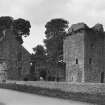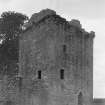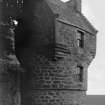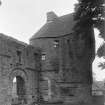Field Visit
Date 20 June 1928
Event ID 1099387
Category Recording
Type Field Visit
Permalink http://canmore.org.uk/event/1099387
Burleigh CastIe.
The ruin of Burleigh Castle, the necessary steps to preserve which have recently been taken by H.M. Office of Works, is situated less than half a mile east of Milnathort, on a small plateau rising from low and once marshy ground on the right bank of the Burleigh Burn near Loch Leven. The approach has been from the west, and on that side there has been a ditch, the line of which can still be made out.
The oldest part of the castle is the tower, which stands at the northern end of the site, and which dates from the early 16th century. Presumably it had a barmkin attached to it. Of this, however, no trace remains. The later enclosure, now represented only by one of its outer walls and by the south-west tower, was built in the last quarter of the 16th century.
The old tower-is oblong on plan, measuring 32 feet 2 inches by 27 feet externally. It contains four main storeys, and the remains of an attic storey appear above the wall-head. The masonry is of rubble brought to courses. Two of the windows are built with rough relieving arches. In all of them the arrises are chamfered or rebated. There are no gun-holes. The wallhead has finished in a parapet and walk, borne on the existing triple-membered corbel-course, the outer members of which are continuous, while the inner one consists of separate corbels. At three of the angles there have been' rounds,' while the north-eastern angle has been surmounted by the cap-house in which the turnpike finished.
On the east is the entrance, the jambs of which have been repaired, while the head is modern. It opens into a lobby, on the north side of which is the turnpike. The latter has been restored up to the hall or first-floor level, but originally it rose to the cap-house. The ground floor, into which the lobby projects, contains a single cellar, lit from the east and south and vaulted. The hall similarly occupies the whole of the floor above, except the space required for the turnpike. It has a window in-each wall, the southern one being provided with seats, while the one opposite has given access to a small projecting wing, subsequently erected against the north wall of the tower but now demolished. The north-west corner of the room has an angled garderobe with a flue. In the east wall is the fireplace and in the south wall an aumbry. The one chamber on the second floor is lit from east and west, both windows having seats within their embrasures; the fireplace is in the south wall, and there is an angled garderobe in the north-east corner. That on the third floor has a fireplace on the north and a small window beside it, a second window on the east, and an aumbry in the south wall.
The accommodation and its arrangement, as just described, represent what is usually found in a laird's house of the period. In 1582 an outbuilding or range was built in alignment with the west wall of the tower and ran southwards, forming the western boundary of a courtyard and terminating at the south-western angle in a small tower. This tower is entire. Of the range all that has survived is two storeys of its outer or west wall, but corbels on the inner side of that wall and a raggle for its roof, cut in the south wall of the old tower, are sufficient to indicate that there was a third storey which can only have been a narrow gallery, constructed mainly of timber. The southern side of the courtyard was bounded by a three-storeyed building, which also abutted on the south-west tower. This building was latterly reduced a storey in height and, finally, demolished. The entrance to the courtyard, an archway wrought with a quirked edge-roll and sheltered beneath a hood-mould, is situated in the surviving wall and is surmounted by a space for an armorial panel. On either side of it is a gun-hole, and others are formed in the ground floor of the south-west tower where shown on the plan; the small circular openings formed in the breasts of the upper windows of the south-west tower may also be for defence, but are more likely to have been provided for ventilation and so, strictly to be 'shot-holes' (=shut-holes, shutter-holes). At its lower part the south-west tower is circled but it has a rounded projection at the northern angle containing a turnpike which, in a later arrangement, could be entered directly from the outside, but the doorway is now filled in. The upper part of the south-west tower is developed to a rectangular plan for simplicity in roofing. The gables finish in skew-stones and not in the more usual crowsteps. The north skew-put bears the date 1582 on its upper surface, and on the lower part is a shield accompanied by the initials S.I.B. and M.B., evidently representing Sir James Balfour of Pittendreich, who died in 1583, and his wife Margaret Balfour, heiress of Burleigh. The shield bears: On a chevron an otter's head erased, in base a rose, for Balfour of Burleigh. The rose is a difference for Burleigh and is represented on the south-east skew-put.
The transe which passed beneath the western range and gave access to the enclosure has not been vaulted; the remains of the range are so fragmentary that no details of its arrangement can be given. The south-west tower was originally entered, as at present, from within the enclosure. The entrance opens at the foot of the turnpike. The lowest chamber, which is irregularly shaped and is covered with a vault, is entered through the stair-well. It is provided with a sink and locker, and is lit only from the four gun-holes looking out towards the southeast, south, west, and north - west. The embrasures are fitted for gun-mountings, two of which remain, though greatly decayed. The stair now rises to the first floor only, where the chamber is pentagonal in shape and has a late fireplace on the east with a locker on each side of it; in the back of the southern locker is a gun-hole. There are windows to south and west with 'shot-holes' in their breasts, and on the north-west is a close garderobe. Near the west window is another locker. The chamber on the second floor is very similar, and the windows have 'shot-holes' in their breasts. On its two upper floors this tower has communicated with the contemporary range which formerly enclosed the courtyard on its southern side.
RCAHMS 1933, visited 20 June 1928.













